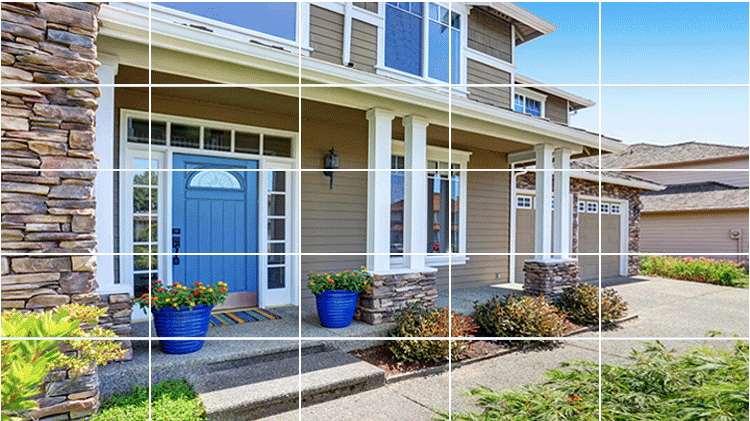Activity Zones are available for all Blink cameras. Setting Activity Zones allow you to eliminate areas in your camera's field of view which may be causing too many motion notifications.
For example, if your Outdoor camera view has a tree or bush that is triggering unwanted motion clips, you can adjust your Activity Zones to exclude that area. The camera will ignore the motion occurring in the Activity Zone which prevents sending unwanted motion notifications.
Creating Activity Zones
- Choose the camera that you want to add Activity Zones to and tap More
 . Then select Device Settings
. Then select Device Settings .
. - From Device Settings, select Motion Settings and then tap Motion Zones.
- On the Activity Zones screen, the most recent thumbnail is shown with a grid pattern.
Tap Update Photo to refresh the thumbnail image so your settings are accurate. - Select your desired inactive Activity Zones by tapping on the rectangle you would like to isolate. A selected area will become grayed out. The area within the gray square will not detect motion, even if motion occurs.
In the example below, bushes and plants are chosen as inactive Activity Zones since these outdoor elements may cause unnecessary motion events.
Note: The Advanced option in the Motion Zones screen is only available for Mini 2, Outdoor 4, Wired Floodlight, Indoor and Outdoor (3rd Gen), and XT2 cameras. This allows you to zoom into the thumbnail for more precise zone selection. When using the Advanced option, swipe to move the view and tap to select areas that are active or inactive for motion detection. When you're done, tap Save.
- After you've selected your desired inactive Activity Zones, tap Done. To make all zones active and restart the process, tap Reset Zones.
Privacy Zones
Privacy Zones allow you to block off areas in your camera view that will not be recorded. This is only available for the Mini 2, Outdoor 4, Wired Floodlight, Video Doorbell and Indoor and Outdoor (3rd Gen) Camera. Learn about on-camera Privacy Zones.
Troubleshooting
Activity Zones
If you're experiencing issues with Activity Zones, it's important to understand how Activity Zones work.
In a typical event without Activity Zones enabled, the camera uses the Passive Infra-Red (PIR) sensor to detect motion. If a person walks past the camera, that person has a different temperature than the background image that the PIR sensor has been looking at and it triggers a motion event.
With Activity Zones, the camera uses the PIR sensor in addition to analyzing the image to look for changes. The camera analyzes the motion event over the course of two seconds and looks for pixels in the images changing.
- If the camera sees pixels changing within an Activity Zone, the camera turns off and stops recording.
- If the camera sees pixels changing in non-Activity Zones, the camera continues to record and will send the notification.
Considerations
In certain situations, pixels can change outside of your Activity Zones when there technically isn't motion.
- Example: Your camera is pointing toward the street, but you have Activity Zones on the part of the view that is the street to keep passing cars from sending you notifications. During the day, Activity Zones function as intended. However at night, a car's headlights could shine into areas outside of your Activity Zones. This could be perceived as motion by the camera, as it would see pixels change, and therefore send you an unwanted notification.
To fix the above scenario, you may need to fine tune the precise positioning and angle of the camera, as well as adjusting Activity Zones so that you can find out what works best in your environment.
If you're continuing to have difficulty with unwanted notifications, learn more by visiting Troubleshooting Motion Notifications.
DeleteDoorbell
The Blink Video Doorbell can use Activity Zones to block off areas of activity where you do not want alerts. In addition to using Activity Zones, Blink offers the Wedge or Corner Mount to help you shift the camera view enough to avoid unwanted motion alerts.
When the doorbell is pointed toward a street for instance, traffic may cause unwanted alerts. Using a wedge mount to point the camera 5º down can help this situation by moving the main activity zone below the horizon.
The Wedge changes the doorbell camera view up or down 5º.
The Corner Mount changes the view 25º to the left or the right.
Learn more about installing a wedge or corner mount.